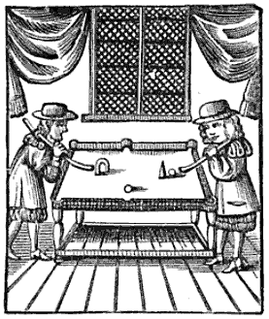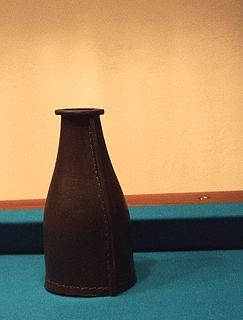Related Research Articles

Cue sports are a wide variety of games of skill played with a cue, which is used to strike billiard balls and thereby cause them to move around a cloth-covered table bounded by elastic bumpers known as cushions.

Eight-ball is a pool billiards played on a billiard table with six pockets, cue sticks, and sixteen billiard balls: a cue ball and fifteen object balls. The object balls include seven solid-colored balls numbered 1 through 7, seven striped balls numbered 9 through 15, and the black 8 ball. After the balls are scattered with a break shot, a player is assigned either the group of solid or striped balls once they have legally pocketed a ball from that group. The object of the game is to legally pocket the 8-ball in a "called" pocket, which can only be done after all of the balls from a player's assigned group have been cleared from the table.

Nine-ball is a discipline of the cue sport pool. The game's origins are traceable to the 1920s in the United States. It is played on a rectangular billiard table with pockets at each of the four corners and in the middle of each long side. Using a cue stick, players must strike the white cue ball to pocket nine colored billiard balls, hitting them in ascending numerical order. An individual game is won by the player pocketing the 9-ball. Matches are usually played as a race to a set number of racks, with the player who reaches the set number winning the match.

English billiards, called simply billiards in the United Kingdom and in many former British colonies, is a cue sport that combines the aspects of carom billiards and pool. Two cue balls and a red object ball are used. Each player or team uses a different cue ball. It is played on a billiards table with the same dimensions as one used for snooker and points are scored for cannons and pocketing the balls. English billiards has also, but less frequently, been referred to as "the English game", "the all-in game" and (formerly) "the common game".

Straight pool, which is also called 14.1 continuous and 14.1 rack, is a cue sport in which two competing players attempt to pot as many billiard balls as possible without playing a foul. The game was the primary version of pool played in professional competition until it was superseded by faster-playing games like nine-ball and eight-ball in the 1980s.
Golf billiards is a pocket billiards game usually played for money. Unlike the majority of such games, it allows more than two people to play without compromises or rule changes. The game borrows from the outdoor game of golf, which is historically related to the cue sports. It is usually played on 10-foot or 12-foot snooker tables as their size and structure are more appropriate.

Russian pyramid, also known as Russian billiards, is a form of billiards played on a large billiard table with narrow pockets. It is popular across Eastern Europe as well as countries of the former Soviet Union/Eastern Bloc. In Western countries, the game is known as pyramid billiards, or simply pyramid within professional circles.

Straight rail, also called straight billiards, three-ball billiards, or the free game, is a discipline of carom billiards that is the most basic form of the game. The game is played on a pocketless unmarked billiard table, usually 10 by 5 feet in size, and three billiard balls, one, usually white, that serves as the cue ball for the first player, a second cue ball for the second player, and an object ball, usually red. The object of the game is to score points by striking the player's assigned cue ball with a cue stick so it makes contact with both the opponent's cue ball and the object ball in the same stroke, known as a carom. Games are played to a predetermined number of points.

Pool is a classification of cue sports played on a table with six pockets along the rails, into which balls are deposited. Each specific pool game has its own name; some of the better-known include eight-ball, blackball, nine-ball, ten-ball, seven-ball, straight pool, one-pocket, and bank pool.

Four-ball billiards or four-ball carom is a carom billiards game, played on a pocketless table with four billiard balls, usually two red and two white, one of the latter with a spot to distinguish it. Each player is assigned one of the white balls as a cue ball. A point is scored when a shooter's cue ball caroms on any two other balls in the same shot. Two points are scored when the shooter caroms on each of the three object balls in a single shot. A carom on only one ball results in no points, and ends the shooter's inning.
The following is a glossary of traditional English-language terms used in the three overarching cue sports disciplines: carom billiards referring to the various carom games played on a billiard table without pockets; pool, which denotes a host of games played on a table with six pockets; and snooker, played on a large pocket table, and which has a sport culture unto itself distinct from pool. There are also games such as English billiards that include aspects of multiple disciplines.

Three-ball is a folk game of pool played with any three standard pool object balls and cue ball. The game is frequently gambled upon. The goal is to pocket the three object balls in as few shots as possible. Theoretically, any number of players can participate, in rotation, but more than five can become unwieldy. The game involves a somewhat more significant amount of luck than either nine-ball or eight-ball, because of the disproportionate value of pocketing balls on the break shot and increased difficulty of doing so. In some areas and subcultures, such as the Asian-American youth-dominated pool hall scene of San Francisco, California, three-ball is a popular local tournament game.
Cowboy pool is a hybrid pool game combining elements of English billiards through an intermediary game, with more standard pocket billiards characteristics. The game employs four balls, the cue ball and three others, numbered one, three, and five. A game of Cowboy pool is contested as a race to 101 points, with those points being awarded for a host of different shot types. Dating back to 1908, the game is a strictly amateur pastime.

Five-pin billiards or simply five-pins or 5-pins, is today usually a carom billiards form of cue sport, though sometimes still played on a pocket table. In addition to the customary three balls of most carom games, it makes use of a set of five upright pins (skittles) arranged in a "+" pattern at the center of the table. The game is popular especially in Italy and Argentina, but also in some other parts of Latin America and Europe, with international, televised professional tournaments. It is sometimes referred to as Italian five-pins or Italian billiards, or as italiana. A variant of the game, goriziana or nine-pins, adds additional skittles to the formation. A related pocket game, with larger pins, is played in Scandinavia and is referred to in English as Danish pin billiards, with a Swedish variant that has some rules more similar to the Italian game.

Baseball pocket billiards or baseball pool is a pocket billiards (pool) game suitable for multiple players that borrows phraseology and even some aspects of form from the game of baseball. For instance, although baseball pool is played on a standard pool table, the 9 ball is known as the "pitcher", the table's foot spot where balls are racked is known as "home plate", and each team or player is afforded "nine innings" to score as many "runs" as possible.

Bottle pool, also known as bottle-billiards and bottle pocket billiards, is a hybrid billiards game combining aspects of both carom billiards and pocket billiards. Played on a standard pool table, the game uses just two object balls, a cue ball, and a 6¾ inch (171 mm) tall, narrow-necked bottle called a shake bottle or tally bottle, traditionally made from leather, that is placed on the table and used as a target for caroms. Those unfamiliar with the game sometimes mistakenly use its name as a synonym for the very different game of kelly pool. Bottle pool has been described as combining "elements of billiards, straight pool and chess under a set of rules that lavishly rewards strategic shot making and punishes mistakes with Sisyphean point reversals."

Cribbage, sometimes called cribbage pool, fifteen points and pair pool, is a two-player pool game that, like its namesake card game, has a scoring system which awards points for pairing groups of balls that total 15. Played on a standard pool table, participants who pocket a ball of a particular number are required to immediately pocket the companion ball that tallies to 15 when added to the prior ball's number. Each pair so pocketed counts as a cribbage; there are seven such pairs, and the 15 ball counts as an eighth by itself after all of the others have been pocketed. The first player to score five cribbages wins the game.
Carom billiards and pool are two types of cue sports or billiards-family games, which as a general class are played with a stick called a cue which is used to strike billiard balls, moving them around a cloth-covered billiard table bounded by rubber cushions attached to the confining rails of the table.

Fifteen-ball pool, also known as sixty-one pool, is a pocket billiards game developed in America in the nineteenth century from pyramid pool. Created by members of the Bassford's Billiard & Chess Rooms in Manhattan during the late 1830s or 1840s, it is the ancestor to many American pool games.
Slosh is a cue sport played on a snooker table. The game features seven balls, coloured white, yellow, green, brown, blue, pink and black, with points being scored for pocketing or playing caroms and cannons off object balls. The game is played to a score of 100 points, or a length of 30 minutes. First played in the early 1900s, not much is known about the game's origins.
References
- 1 2 Billiards, Revised and Updated. Lyons Press. 1992. pp. 90–92. ISBN 9781461749929 . Retrieved September 12, 2022.
- 1 2 Rather, Billie; Rather, Megan (April 1992). Pool Pointers. Billing. pp. 78–79. ISBN 0-380-76136-X.
- 1 2 3 4 5 6 BCA Rules Committee (1998). Billiards - The Billiard Congress of America Official Rules and Records Book (50th anniversary commemorative ed.). Coralville, Iowa: Billiard Congress of America. pp. 81–2, 132–3. ISBN 1-878493-08-6.
- ↑ Shamos, Mike (March 20, 2000). The Complete Book of Billiards. Random House Value Publishing. p. 121. ISBN 9780517208694.
- 1 2 3 Shamos, Mike (1993). The Illustrated Encyclopedia of Billiards . New York City: Lyons & Burford. p. 117. ISBN 1-55821-219-1.
- ↑ Billiard Congress of America (1995–2005). General Rules of Pocket Billiards - Rule 3.4 Archived December 5, 2006, at the Wayback Machine . Retrieved December 21, 2006.
- ↑ Billiard Congress of America (May 1, 2005). Billiards, Revised and Updated: The Official Rules And Records Book. Rowman & Littlefield. ISBN 9781461749929.
- ↑ Official file book for All Pocket & Carom Billiard Games. Iowa City: Billiard Congress of America. 1992. p. 82.
